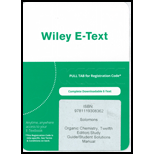
Interpretation:
The structure of codling moth sex pheromone is to be given with the help of given information.
Concept Introduction:
Electrophiles are electron deficient species which has positive or partially positive charge. Lewis acids are electrophiles which accept electron pair.
Nucleophiles are electron rich species which has negative or partially negative charge. Lewis bases are nucleophiles which donate electron pair.
Free radical is an atom, molecule or ion that has unpaired electrons which makes it highly chemically reactive.
Substitution reaction: A reaction in which one of the hydrogen atoms of a hydrocarbon or a
Elimination reaction: A reaction in which two substituent groups are detached and a double bond is formed is called elimination reaction.
Addition reaction: It is the reaction in which unsaturated bonds are converted to saturated molecules by the addition of molecules.
The reaction in which hydrogen is added to the compound in the presence of catalyst is known as hydrogenation.
The number of moles of hydrogen absorbed will be equal to the number of double bonds.
Reduction is a process in which hydrogen atoms are added to a compound. Usual reagents used in the reduction process are
The reaction in which the
Reduction is a process in which the addition of hydrogen atoms to a compound takes place.
During an addition reaction unsaturated bonds are converted into saturated molecules by the addition of molecules
Ozonolysis is a process in which the given alkene is cleaved with ozone
The
First, give priority according to Cahn-Ingold-Prelog convention rules:
The higher the
If priority cannot be assigned according to atomic mass, then assign the priority according to the first point of difference.
If both the priority groups are on the same side of a double-bonded carbon atom, then it is known as
But if both the priority groups are diagonal to each other, then it is
Want to see the full answer?
Check out a sample textbook solution
Chapter 8 Solutions
ORGANIC CHEMISTRY-ETEXT REG ACCESS
- 4) Aromatic compounds are among the most abundant and versatile in nature. From a synthetic point of view, these compounds, despite their stabilities, are quite useful and can undergo reactions under special conditions and by specific mechanisms, such as the Electrophilic Aromatic Substitution (SAE) and the Nucleophilic Aromatic Substitution (SNAr). Based on this, please answer the following items: (b) How would you prepare the following compounds starting from benzene? Explain the second in a different wayarrow_forwardDraw the structure of (2Z, 6E)-3-ethyl-7-methyldeca-2, 6-dien-1-ol, the sex pheromone of the codling moth, a common agricultural pest that destroys apple crops. By spraying an apple orchard with this pheromone, the mating of male and female moths is disrupted, and moth populations can be controlled.arrow_forwardMany multi-step organic reaction mechanisms involve proton transfer steps. For example, the first step of Fischer esterification of carboxylic acids(as shown with acedic acid) is activation of the acid by protonation. Based on your understanding of which reaction pathway is more favorable, explain why using chemical structures.arrow_forward
- An aromatic compound K, whose molecular formula is C8H11N, is examined in the laboratory to elucidate its structure. The following observations were made: A) Compound K is soluble in dilute hydrochloric acid but insoluble in sodium hydroxide solution. B) Treatment of compound K with excess potassium hydroxide and benzenesulfonyl chloride, C(6)H(5)SO(2)Cl, results in the formation of a heterogeneous mixture. The NMR spectrum of compound K is shown below. C) Compound K when treated with acetic anhydride[CH3-C(O)-O-C(O)-CH3], gives compound L, whose molecular formula is C(10)H(13)ON. Compound L is insoluble in dilute acid or dilute base at room temperature, heating compound L in dilute acid or base, however, regenerates compound K. D) When compound L is heated with a mixture of concentrated nitric acid and sulfuric acid, a single product, compound M, with the molecular formula C(10)H(12)O(3)N(2) is formed in excellent yields. On the basis of these observations draw the structures of…arrow_forwardGive reasons for the following :(i) Phenol is more acidic than methanol.(ii) The C—O—H bond angle in alcohols is slightly less than the tetrahedral angle (190°28′).(iii) (CH3)3C—O—CH3 on reaction with HI gives (CH3)3C—I and CH3—OH as the main products and not (CH3)3C—OH and CH3—I.arrow_forwardCompound A and compound B both have molecular formula C6H12. Both compounds produce epoxides when treated with a peroxy acid (RCO3H). The epoxide resulting from compound A was treated with aqueous acid (H3O+) and the resulting diol has no chiral centers. Identify the two possible structures for compound A (enter two numbers separated by commas with no spaces, e.g. "1,2") The epoxide resulting from compound B was treated with (H3O*) and the resulting diol was a meso compound. Identify compound B 2 3 potn 7 1 5 6 4 8arrow_forward
- The hydrocarbon fluorene was treated with potassium t-butoxide in an acid-base reaction, giving the fluorenide anion and t-butyl alcohol. (a) Which way does the equilibrium lie, and by how much? b) What is the proportion of the fluorenide anion to fluorene? (c) Why is fluorene so highly acidic, considering the pKa of an average alkane is above 50?arrow_forwardGive reasons for the following :(i) Ethyl iodide undergoes SN2 reaction faster than ethyl bromide.(ii) (±) 2-Butanol is optically inactive.(iii) C—X bond length in halobenzene is smaller than C—X bond length in CH3—X.arrow_forward

 Introduction to General, Organic and BiochemistryChemistryISBN:9781285869759Author:Frederick A. Bettelheim, William H. Brown, Mary K. Campbell, Shawn O. Farrell, Omar TorresPublisher:Cengage Learning
Introduction to General, Organic and BiochemistryChemistryISBN:9781285869759Author:Frederick A. Bettelheim, William H. Brown, Mary K. Campbell, Shawn O. Farrell, Omar TorresPublisher:Cengage Learning Organic ChemistryChemistryISBN:9781305580350Author:William H. Brown, Brent L. Iverson, Eric Anslyn, Christopher S. FootePublisher:Cengage Learning
Organic ChemistryChemistryISBN:9781305580350Author:William H. Brown, Brent L. Iverson, Eric Anslyn, Christopher S. FootePublisher:Cengage Learning


